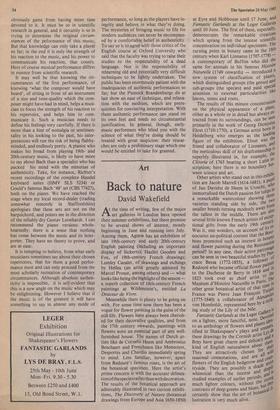Art
Back to nature
David Wakefield
Athe time of writing, few of the major art galleries in London have opened their summer exhibitions, but there promise to be several shows of interest, mostly beginning in June and running into July. Among them, Agnew has an exhibition of late 19th-century and early 20th-century English painting (including an important display of Sickerts); Hazlitt Gooden and Fox, of 19th-century French drawings; Lumley Cazalet, of drawings and etchings by Helleu (an artist greatly admired by Marcel Proust, among others) and — what looks like being the highlight of the season a superb collection of 18th-century French paintings at Wildenstein's, entitled La Douceur de Vivre.
Meanwhile there is plenty to be going on with. For some time now there has been a vogue for flower painting in the guise of the still-life. Flowers have always been cherish- ed for their decorative qualities, and from the 17th century onwards, paintings with flowers were an essential part of any well- furnished house. The names of Dutch ar- tists like de Cornelis Heem and Ambrosius Boschaert and Frenchmen like Monnoyer, Desportes and Chardin immediately spring to mind. Less familiar, however, apart from Redoute's famous roses, is the art of the botanical specimen. Here the artist's prime concern is with the accurate delinea- tion of thespecies rather than with decoration. The results of the botanical approach are admirably illustrated in two current exhibi- tions, The Discovery of Nature (botanical drawings from Europe and Asia 1650-1850) at Eyre and Hobhouse until 17 June, and Fantastic Garlands at the Leger Galleries until 10 June. The first of these, especially, demonstrates the remarkable creations which sprang from the intense scientific concentration on individual specimens. The turning point in botany came in the 18th century when Karl Linnaeus (1707-1778) — a contemporary of Buffon who did the same for animals in his famous Histoire Naturelle (1749 onwards) — introduced a new system of classification of Plants, which distinguished groups (the genus) and sub-groups (the species) and paid special attention to external particularities like leaves, stems and roots. The results of this minute concentration on the physical appearance of a Plant' either as a whole or in detail but always ex- tracted from its surroundings, can be seen primarily in the work of Georg Dionysius Ehret (1710-1770), a German artist born la Heidelberg who emerges as the leading figure of the exhibition. Ehret was tile, friend and collaborator of Linnaeus, and the meticulous skill of his draftsmanship is superbly illustrated in, for example, the Clitoria of 1763 bearing a short Latin ia" scription; here there is no boundary bet- ween science and art.• Other artists who stand out in this ex it tion are Jacob Marrell (1614-1681), a Pa,P,I of Jan Davidsz de Heem in Utrecht, vol. immortalised the Dutch passion for tuliPs al a remarkable watercolour showing three varieties standing side by side, the two smaller breeds turning modestly away from the tallest in the middle. There are Ws' several little-known French artists of excel:: tional gifts from the early 19th century : Was it, one wonders, on account of its nocuous un-political content that the bo Bb tan bons promoted such an interest in any and flower painting during the Restoratl°, period? In any case, their active patrona!, can be seen in two beautiful studies by Pa oPf crate Bessa (1772-1855), a follower ter Redoute who became official flower PaT in to the Duchesse de Berry in 1816 anatile 1823 took over as chief artist td The Museum d'Histoire Naturelle in Fari' e other great botanical artist of that time France was Pierre Jean Francois Tarl' (1775-1840) a collaborator of Alea sxalltilkel- von Humboldt, represented here by
ing study of the Lily of the Nile.
riallerY is Fantastic Garlands at the Leger — oted on a lighter, more fanciful, note. Dev,,eg.. to an anthology of flowers and plants nets, tified in Shakespeare's plays and s9,11„5 cie these drawings by the Cornish artist and a Bray have great charm and delicacy ;co, kind of English naturalness about their They are attractively chosen f°r„ seasonal connotations, and are flowers of the English hedgerow and COtoe tryside. They are possibly a sbade,eeplY whimsical than the intense and "nd studied examples of earlier periods, astrod much lighter colours, without the, t tileY contrasts of deep greens and blues; certainly show that the art of botanm' lustration is very much alive.














































 Previous page
Previous page